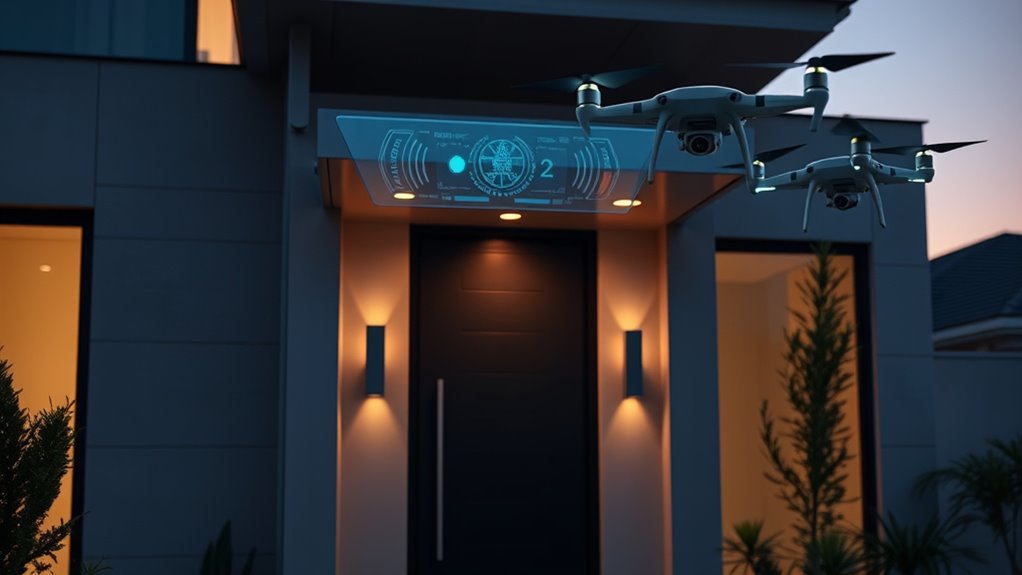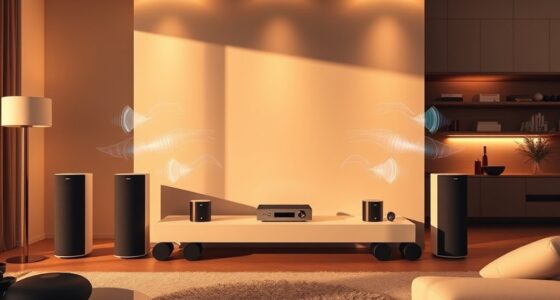Next-generation home security combines autonomous features and AI protection to make your home smarter and safer. You can control smart locks remotely, grant temporary access, and automate locking schedules, all while AI analyzes access patterns to detect suspicious activity. Facial recognition identifies familiar faces and alerts you to strangers, enhancing security layers. This integrated system offers proactive monitoring and quick responses. Keep exploring to discover how these innovative solutions can transform your home security.
Key Takeaways
- Autonomous home security systems integrate smart locks, facial recognition, and AI analysis for seamless access control and threat detection.
- AI-powered security solutions analyze access patterns to identify suspicious activity and prevent unauthorized entry proactively.
- Facial recognition automates door access for authorized users, reducing reliance on physical keys and enhancing security.
- The integrated ecosystem combines multiple technologies for real-time monitoring, automated responses, and comprehensive security management.
- Future trends focus on adaptive, intelligent systems that evolve to provide enhanced convenience, safety, and proactive threat mitigation.

Are you ready to experience the future of home security? With the rapid advancement of technology, your home is about to become smarter, safer, and more responsive than ever before. One of the most significant innovations shaping this future is the seamless integration of smart locks. Smart lock integration allows you to control access to your home remotely, giving you the power to lock or open doors from anywhere using your smartphone. No more fumbling for keys or worrying about lost key copies. Instead, you can grant temporary access to guests or service providers directly through an app, and you can even set schedules for when locks automatically engage or disengage. This level of control not only adds convenience but also enhances security by eliminating common vulnerabilities like lost keys or lock picking. AI security solutions further bolster these systems by analyzing access patterns and detecting anomalies to prevent unauthorized entry.
Complementing these smart locks is facial recognition technology, a game-changer for personalized security. With facial recognition, your home can automatically identify family members, friends, or even unfamiliar visitors. When someone approaches your front door, the system scans their face and cross-references it with your stored database. If recognized, the door opens, and you receive a notification, allowing you to greet your guest remotely or prepare for their arrival. If an unfamiliar face is detected, the system can trigger alerts or activate other security measures, such as recording footage or locking down access. Facial recognition technology reduces the need for physical keys or codes, minimizing the risk of unauthorized entry, and provides a highly personalized security experience tailored to your household.
These innovations work hand-in-hand to create a more intelligent home security ecosystem. Smart lock integration guarantees that access points are secure and manageable in real-time, while facial recognition adds an extra layer of verification, making it harder for intruders to bypass security. Together, they enable you to automate security routines, monitor access history, and respond instantly to unexpected events. The combination of these features means you’re not just reacting to threats—you’re proactively preventing them.
In an era where convenience and security go hand in hand, embracing smart lock integration and facial recognition technology puts you ahead of potential risks. You gain peace of mind knowing your home adapts to your lifestyle, responds instantly to threats, and keeps your loved ones safe. The future of home security isn’t just about cameras and alarms; it’s about intelligent systems that learn, adapt, and protect with precision and ease. So, get ready to welcome this new era—your smarter, safer home awaits.
Frequently Asked Questions
How Do Autonomous Security Features Adapt to Different Home Layouts?
You can easily customize autonomous security features to fit your home’s smart layout through adaptive detection. The system learns your home’s specific layout, adjusting sensors and cameras accordingly. It recognizes unique features and potential blind spots, ensuring thorough coverage. This way, your security adapts seamlessly to different home designs, providing reliable protection without requiring manual adjustments. The result is a tailored, intelligent security setup that keeps your home safe and monitored effectively.
What Privacy Measures Protect User Data in Ai-Powered Security Systems?
Think of your data as the crown jewels—protected fiercely. Your security system uses data encryption to keep your information safe from prying eyes. It also requires your explicit user consent before collecting or sharing data, ensuring you’re in control. These measures act like a digital shield, safeguarding your privacy while allowing the AI to operate effectively. Trust that your data stays private, just as you’d guard your most valued possessions.
How Reliable Are AI Alerts Compared to Traditional Security Alarms?
AI alerts are generally more reliable than traditional security alarms, but false positives can occur, which might cause unnecessary alarm. This can affect your trust in the system if alerts aren’t accurate. However, as AI technology improves, false positives decrease, enhancing user trust. You’ll find that AI-powered security offers quicker, smarter responses, but it’s essential to calibrate alerts properly to guarantee you feel confident in its reliability.
Can These Systems Integrate With Existing Home Automation Devices?
Yes, these systems can seamlessly synchronize with your existing home automation devices. You’ll find device compatibility improves setup ease, making integration simple and smooth. However, some integration challenges may arise, especially with older or less common devices. To guarantee a hassle-free harmony, check compatibility beforehand, and consider consulting professionals if needed. With proper planning, your smart security system will synchronize seamlessly, strengthening your home’s safety and smart functionality.
What Are the Costs Associated With Upgrading to Next-Generation Security?
Upgrading to next-generation security involves costs that vary based on features and system complexity. You should perform a thorough cost analysis to understand expenses for equipment, installation, and ongoing subscriptions. Financing options are often available, making upgrades more affordable by spreading payments over time. Consider these factors carefully to guarantee the investment aligns with your budget while providing enhanced autonomous features and AI protection for your home security.
Conclusion
As you embrace next-generation home security with autonomous features and AI protection, remember that technology offers powerful peace of mind. Yet, it also invites new vulnerabilities and ethical considerations that demand your vigilance. While automation can detect threats before you notice them, it can’t substitute the human intuition and judgment that truly safeguard your home. Balancing innovation with awareness ensures your security remains robust, blending the best of advanced tech and personal awareness.








